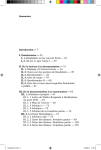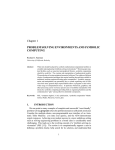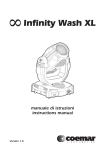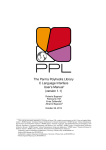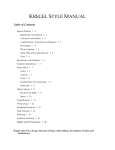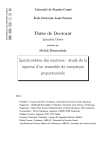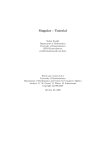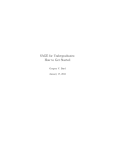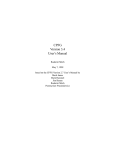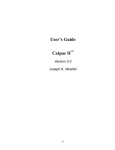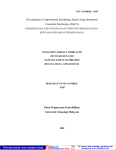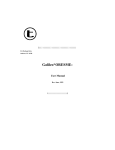Download Elementary Number Theory
Transcript
Elementary Number Theory
Minh-Tam Trinh
after
Ngô Bảo Châu
University of Chicago
Fall 2015
Contents
0 Preface
1 27 September
1.1 Background . . . . . . . . . .
1.1.1 Sets . . . . . . . . . .
1.1.2 Functions . . . . . . .
1.1.3 Equivalence Relations
1.1.4 Factoring and Series .
1.2 Classical Proof Techniques . .
1.2.1 Contradiction . . . . .
1.2.2 Induction . . . . . . .
1.3 Abstract Algebra . . . . . . .
1.3.1 Groups . . . . . . . .
1.3.2 Rings and Fields . . .
2
.
.
.
.
.
.
.
.
.
.
.
.
.
.
.
.
.
.
.
.
.
.
.
.
.
.
.
.
.
.
.
.
.
.
.
.
.
.
.
.
.
.
.
.
.
.
.
.
.
.
.
.
.
.
.
.
.
.
.
.
.
.
.
.
.
.
.
.
.
.
.
.
.
.
.
.
.
.
.
.
.
.
.
.
.
.
.
.
.
.
.
.
.
.
.
.
.
.
.
.
.
.
.
.
.
.
.
.
.
.
.
.
.
.
.
.
.
.
.
.
.
.
.
.
.
.
.
.
.
.
.
.
.
.
.
.
.
.
.
.
.
.
.
.
.
.
.
.
.
.
.
.
.
.
.
.
.
.
.
.
.
.
.
.
.
.
.
.
.
.
.
.
.
.
.
.
.
.
.
.
.
.
.
.
.
.
.
.
.
.
.
.
.
.
.
.
.
.
.
.
.
.
.
.
.
.
.
.
.
.
.
.
.
.
.
.
.
.
.
.
.
.
.
.
.
.
.
.
.
.
.
.
.
.
.
.
.
.
.
.
.
.
.
.
.
.
.
.
.
.
.
.
.
.
.
.
.
.
.
.
.
.
.
.
.
.
.
.
.
.
.
.
.
.
.
.
.
.
.
.
.
.
.
.
.
.
.
.
.
.
.
.
.
.
.
.
.
.
.
.
.
.
.
.
.
.
.
.
.
.
.
.
.
.
.
.
.
.
.
3
3
3
3
4
4
5
5
5
6
6
8
2 6 October
10
2.1 Divisors . . . . . . . . . . . . . . . . . . . . . . . . . . . . . . . . . . . . . . . . . 10
2.2 Prime Factorization . . . . . . . . . . . . . . . . . . . . . . . . . . . . . . . . . . 11
3 13 October
13
3.1 Rings of Residues Modulo m . . . . . . . . . . . . . . . . . . . . . . . . . . . . . 13
3.2 Linear Congruences . . . . . . . . . . . . . . . . . . . . . . . . . . . . . . . . . . . 13
3.3 The Newton-Hensel Method . . . . . . . . . . . . . . . . . . . . . . . . . . . . . . 15
4 20 October
18
4.1 Arithmetic Functions . . . . . . . . . . . . . . . . . . . . . . . . . . . . . . . . . . 18
4.2 Unit Groups Modulo m . . . . . . . . . . . . . . . . . . . . . . . . . . . . . . . . 19
5 27 October
22
5.1 Criteria for Quadratic Residues . . . . . . . . . . . . . . . . . . . . . . . . . . . . 22
5.2 Quadratic Congruences . . . . . . . . . . . . . . . . . . . . . . . . . . . . . . . . 22
0
Preface
This collection of notes summarizes the first half of the Math 175 course at the University of
Chicago in the Fall 2015 quarter. Written very hastily, it has yet to be proofread carefully. All
mistakes are attributable to the author, not to the instructor. The names we give to mathematical
objects and theorems may differ from those in [JJ].
The section numbers roughly correspond to weeks of the quarter. Throughout, we use the
following conventions:
N = {1, 2, 3, . . .}, the set of natural numbers
Z = {0, ±1, ±2, . . .}, the set of integers
Q = {a/b : a, b ∈ Z and b 6= 0}, the set of rational numbers
R = the set of real numbers
This course is about the algebraic relationships that exist between integers, or more poetically,
the patterns and symmetries hidden within Z and Q. To students: Please, do not feel as though
these notes can only be read front-to-back. They were written to be a “user’s manual,” not a
narrative!
2
1
1.1
27 September
Background
Although everyone enrolled is required to have taken a previous course in proof-based mathematics,
I wanted to review the “standard toolbox” of notations and techniques you should know. I am
doing this because of the wide range of backgrounds that seem to be present among the students.
1.1.1
Sets
The notation x ∈ X is to be read “x is an element of the set X.” If P is a property of elements
of S, then the notation {x ∈ X : x satisfies P} means “the set of all elements x ∈ X such that x
satisfies P.”
If X, Y are sets, then the notation X ⊆ Y is to be read “X is a subset of Y .” The product of
X and Y is the set X × Y whose elements are ordered pairs (x, y) such that x ∈ X and y ∈ Y .
If X, Y are both subsets of another set Z, then we define their intersection to be
(1)
X ∩ Y = {z ∈ Z : z ∈ X and z ∈ Y }
and their union to be
(2)
X ∪ Y = {z ∈ Z : z ∈ X or z ∈ Y }.
The complement of Y in X is the set
(3)
X \ Y = {x ∈ X : x ∈
/ Y }.
The empty set or nullset is the set that contains no elements, which is denoted ∅. The notation
#X means “the number of elements of X,” i.e., the cardinality of X.
1.1.2
Functions
Let f : X → Y be a map. We say that X is the domain of f and Y is the codomain or range of
f . If A ⊆ X, then the image of A under f is the set
(4)
f (A) = {f (a) : a ∈ A} ⊆ Y.
If B ⊆ Y , then the preimage of B under f is the set
(5)
f −1 (B) = {x ∈ X : f (x) ∈ B}.
If y ∈ Y , then mathematicians write f −1 (y) in place of f −1 ({y}) and refer to this set as the
preimage of y under f .
We say that f is injective, or an injection, iff it sends any pair of distinct elements of X to
distinct elements of Y . In other words, f is injective if and only if, for all x1 , x2 ∈ X, we have
that f (x1 ) = f (x2 ) implies x1 = x2 . We say that f is surjective, or a surjection, iff f (X) = Y ,
i.e., every element of Y takes the form f (x) for some x ∈ X.
“Super-Useful Fact”
If X, Y are finite of the same cardinality and f : X → Y is any function, then:
f is injective ⇐⇒ f is surjective.
3
Here is another way of thinking about injectivity and surjectivity:
(6)
f is injective ⇐⇒ the preimage of any element of Y contains at most one element.
(7)
f is surjective ⇐⇒ the preimage of any element of Y contains at least one element.
We say that f is bijective, or a bijection, iff it is both injective and surjective. If f is bijective,
then every element y ∈ Y has a unique preimage in X, so we can define the inverse of f to be
the map f −1 : Y → X that sends y to this unique preimage.
As we see above, the notation f −1 is used in several slightly-different ways. This is an example
of what’s called “abuse of notation.” Certain abuses of notation are tolerated in mathematical
writing because they have proven more convenient than harmful.
1.1.3
Equivalence Relations
If X is a set, then to give an equivalence relation on X is to give a family of pairwise-disjoint
subsets, called equivalence classes, whose union is X.
Example 1.1. This one was suggested by Professor Ngô. Let Monday be the set of all Mondays
in human history, and let Tuesday, . . . , Sunday be defined similarly. Then
(8)
Monday, Tuesday, . . . , Sunday
gives an equivalence relation on the set of dates in human history, because each calendar date
has a unique day-name.
Oftentimes, when working with equivalence relations, we introduce a symbol like ∼ or ≈ or
≡ to indicate that two elements of X belong to the same equvalence class. (Naturally, we say
that such elements are equivalent.) We write X/∼ or an analogous notation to denote the set of
equivalence classes. There is a natural map
(9)
X → X/∼
that sends every element x ∈ X to the unique equivalence class containing x. We often denote
this class by [x], so that x ∼ y is equivalent to [x] = [y] by definition.
Example 1.2. Fix m ∈ N. Then we can define an equivalence relation on Z by setting a ∼ b if
and only if m divides a − b. The corresponding family of subsets of Z is
(10)
0 + mZ, 1 + mZ, . . . , (m − 1) + mZ,
where a + mZ denotes the set of integers of the form a + mq for some q ∈ Z. For this particular
equivalence relation, it is conventional to write
(11)
a ≡ b (mod m)
to mean a ∼ b. We will revisit this example in §3.1.
1.1.4
Factoring and Series
Exercise 1. Let x, y be indeterminates, and let k ∈ N.
1. How do you factor xk − 1?
2. How do you factor xk − y k ?
4
3. How do you factor xk + 1 for odd k? What goes wrong with this pattern for even k?
Exercise 2.
1. Suppose x is an indeterminate. Expand (1 + x + x2 + · · · + xn )(1 − x).
2. Using part (1), deduce that if x is a real number and |x| < 1, then
(12)
1 + x + x2 + · · · + xn
converges to a real number as n → ∞. What is this number, in terms of x?
Exercise 3.
1. Prove that
(13)
1
1
1
1
+
+ · · · + n+1 ≥
2n + 1 2n + 2
2
2
for all nonnegative integers n. You don’t need induction.
2. Deduce that the harmonic series
(14)
1+
1 1
1
+ + ··· +
2 3
n
diverges as n → ∞. This argument was discovered by Nicole Oresme, a French natural
philosopher of the late medieval era.
1.2
Classical Proof Techniques
I use the word “classical” in the conservative (Western) sense of, “known to the intellectual
scene of the ancient Greeks.”
1.2.1
Contradiction
I think everyone in the class understands how this works, so this is the only thing I want to
mention about it:
[R]eductio ad absurdum, which Euclid loved so much, is one of a mathematician’s
finest weapons. It is a far finer gambit than any chess gambit: a chess player may
offer the sacrifice of a pawn or even a piece, but a mathematician offers the game.
—G. H. Hardy in A Mathematician’s Apology
Disclaimer: I disagree strongly with a number of other things Hardy says in that book. On the
other hand, Hardy was in a very melancholic state of mind when he wrote it.
1.2.2
Induction
In the first week, we proved that the principle of induction1 and the well-ordering principle can
be deduced from each other. Anyway, both are true.
Principle of Induction
If P(n) means “property P holds for the natural number n,” then to prove P(n) for all n ∈ N, it
suffices to prove the following two statements:
1 In
this document, “induction” always means “strong induction.”
5
1. Base case. P(1) holds.
2. Inductive step. Given any n ∈ N, if P(m) holds for all m < n, then P(n) holds.
Exercise 4. Prove by induction that 13 + 23 + · · · + n3 = ((n2 + n)/2)2 for all n ∈ N.
Well-Ordering Principle
Every nonempty subset of N contains a smallest element.
Exercise 5. Using the well-ordering principle, show that every nonempty subset of N that is
bounded above has a largest element.
1.3
Abstract Algebra
Traditionally, the subject of algebra began with the writing of The Compendious Book on
Calculation by Completion and Balancing by al-Khwārizmī during the zenith of the Abbasid
Caliphate. This is the book that introduced the idea of “solving the equation for x.” But I would
say that abstract algebra really begins with the invention of zero. What do I mean by this?
Abstract algebra is about introducing seemingly useless structural abstractions into
mathematics that pay back their worth enormously as more and more theory accumulates
around them, until their naturality and simplicity can finally be fully appreciated.
The number 0 was such a concept. If we attribute the discovery of 0 to the Indian mathematician
Pingala, circa 200 BCE, then “abstract algebra” would predate “elementary algebra!”
(To be fair, the notion of an indeterminate variable x was also a revolutionary advance. But
The Compendious Book seems to have focused on establishing the methods for solving linear and
quadratic equations in x, rather than cultivating their abstraction in the way that, say, Galois
did centuries later. The distinction is quite fine and difficult to communicate.)
We here summarize the most important algebraic structures for this course. We will return
to them in closer detail in subsections §3.1 and §4.2.
1.3.1
Groups
A group consists of a set G and a function ∗ : G × G → G, written (a, b) 7→ a ∗ b and called its
law or operation, such that the following hold:
1. Associativity. (a ∗ b) ∗ c = a ∗ (b ∗ c) for all a, b, c ∈ G.
2. Identity. There exists an element e ∈ G, called the identity, such that a ∗ e = a = e ∗ a for
all a ∈ G.
3. Inversion. For every a ∈ G, there exists an element b, called the inverse of a, such that
a ∗ b = e = b ∗ a.
We say that a group is abelian iff it furthermore satisfies:
4. Commutativity. a ∗ b = b ∗ a for all a, b ∈ G.
Exercise 6. Which of the following form groups? Of those that do, which form abelian groups?
6
1. Z under addition.
2. R under addition.
3. R under multiplication.
4. R \ {0} under multiplication.
5. {+1, −1} under multiplication.
6. G1 × G2 (where Gi is a group with the operation ∗i ) under the operation ∗ defined by
(15)
(a1 , a2 ) ∗ (b1 , b2 ) = (a1 ∗1 b1 , a2 ∗2 b2 ).
7. The set of pairs (a1 , a2 ) ∈ R × R such that a 6= 0, under the operation ∗ defined by
(16)
(a1 , a2 ) ∗ (b1 , b2 ) = (a1 b1 , a1 b2 + a2 ).
When the operation is unambiguous from the context, mathematicians often drop the ∗
symbol and write ab in place of a ∗ b. However, if the operation is conventionally referred to as
“addition,” like in parts (1) and (2) of the preceding exercise, then they always keep the symbol
+ to denote the operation, to avoid confusion with multiplication.
If G is a group, then a subgroup of G is a subset H ⊆ G that forms a group in its own right
with the same operation and identity element. This means three things: H is closed under the
operation, i.e., a, b ∈ H implies ab ∈ H; and, H contains the identity of G; and, if a ∈ H, then
a−1 ∈ H. (Actually, the second follows from the first and third.)
Exercise 7.
1. Find all the subgroups of Z. Hint: To get you started, {0} is a subgroup.
2. Show that Z×Z contains subgroups that do not take the form H1 ×H2 for some H1 , H2 ⊆ Z.
If G1 , G2 are groups, then we say that a map f : G1 → G2 is a group homomorphism, or
group morphism, iff
(17)
f (ab) = f (a)f (b)
for all a, b ∈ G1 . Intuitively, f is a homomorphism iff it “sends” the operation of G1 onto that of
G2 . When it is, it necessarily sends the identity of G1 to that of G2 . We say that f is a group
isomorphism iff it is a bijective group homomorphism. In this case we write G1 ' G2 .
Exercise 8. Consider the groups formed by Z and R under addition. Which of the following
are group homomorphisms? Of those that do, which are isomorphisms?
1. The translation map ta : Z → Z defined by ta (n) = n + a, where a ∈ Z is fixed.
2. The scaling map ma : Z → Z defined by ma (n) = an, where a ∈ Z is fixed.
3. The scaling map ma : R → R defined by ma (x) = ax, where a ∈ R is fixed.
4. The map R → R>0 that sends x 7→ ex , where the operation on R>0 = {x ∈ R : x > 0} is
multiplication.
7
1.3.2
Rings and Fields
A ring consists of a set R and functions +, × : R × R → R, where + is called its addition and ×
is called its multiplication, such that:
1. R forms an abelian group under +. Its identity under + is called the additive identity and
denoted 0.
2. × is associative, meaning a × (b × c) = (a × b) × c for all a, b, c ∈ R.
3. There exists an element 1 ∈ R, called the multiplicative identity or unity, such that
a × 1 = a = 1 × a for all a ∈ R.
4. The distributive identities
(18)
a × (b + c) = a × b + a × c
(19)
(b + c) × a = b × a + c × a
hold for all a, b, c ∈ R.
In this course, all rings will be commutative, meaning the multiplication is commutative:
4. a × b = b × a for all a, b ∈ R.
Note that the elements of R “almost” form an abelian group under ×. The only obstacle is that
not every element may have an inverse with respect to ×.
Exercise 9.
1. Show that if R is a ring, then 0 × a = 0 for every a ∈ R. Hint: 0 = 0 + 0.
2. Deduce that if R is nontrivial, meaning 0 6= 1, then 0 cannot have an inverse.
We say that an element a ∈ R is a unit iff it has an inverse b ∈ R with respect to ×, i.e.,
a × b = 1. We write R× for the set of units of R. Then, by construction, R× forms an abelian
group under ×, called the unit group of R. We say that R is a field iff R× = R \ {0}.
Exercise 10. Check that the following objects form rings. Which of them form fields?
1. Z.
2. Q.
3. R.
4. The set R[t] of polynomials in t with real coefficients.
5. R1 × R2 (where R1 , R2 are rings), under the addition
(20)
(a1 , a2 ) + (b1 , b2 ) = (a1 + b1 , a2 + b2 )
and the multiplication
(21)
(a1 , a2 ) × (b1 , b2 ) = (a1 × b1 , a2 × b2 ).
8
Henceforth, we drop the × notation and write ab in place of a × b. If R1 , R2 are rings, then
we say that a map f : R1 → R2 is a ring homomorphism, or ring morphism, iff
(22)
f (a + b) = f (a) + f (b),
(23)
f (ab) = f (a)f (b),
(24)
f (1) = 1,
i.e., f preserves both the addition and the multiplication operations and preserves unity. We
say that f is a ring isomorphism iff it is a bijective ring homomorphism. In this case we write
R1 ' R2 .
Exercise 11. Let R1 , R2 be rings, and consider R1 × R2 under the ring structure described in
part (5) of Exercise 10. Show that the projection map R1 × R2 → R1 that sends (x1 , x2 ) 7→ x1
is a ring homomorphism.
9
2
6 October
2.1
Divisors
Let a, b ∈ Z. As you know well, we say that b divides a, and write b | a, iff there exists q ∈ Z
such that a = bq. In this case, we also say that b is a divisor of a and that a is a multiple of b.
For example, according to this definition, 1 divides everything and everything divides 0.
Theorem 2.1 (Division Algorithm). For all a, b ∈ N, there exist q, r ∈ Z such that
(25)
a = bq + r
and 0 ≤ r < b. We say that q is the quotient and r is the remainder upon long-dividing a by b.
Proof. By Cor. 5 to the well-ordering principle, there is a largest multiple of b that is less than
or equal to a. We can write it as bq for some q ∈ Z. It remains to show that r = a − bq satisfies
r < a. Indeed, if this were not true, then we would have b(q + 1) ≤ bq + r = a, contradicting the
definition of bq.
If a, b ∈ N, then the greatest common divisor (gcd) of a, b is the largest d ∈ N such that
d | a and d | b. It is denoted gcd(a, b). We say that a and b are coprime or relatively prime iff
gcd(a, b) = 1, i.e., the only (positive) common divisor of a and b is 1.
Exercise 12. In this exercise, we demonstrate that there’s a fast algorithm to compute the gcd
of any two natural numbers a, b.
1. Prove that if a, b, q, r ∈ Z such that a = bq + r, then the common divisors of a and b are
precisely the common divisors of b and r.
2. Deduce that if a, b, r ≥ 1 and a = bq + r, then gcd(a, b) = gcd(b, r).
Part (2) implies:
Euclidean Algorithm
If we want to compute the gcd of two numbers a, b ∈ N, where a > b, then we can replace a with
b and replace b with the remainder upon long-dividing a by b, as long as this remainder is
nonzero.
In practice, it looks like this:
3. Let a0 , a1 ∈ N, where a0 > a1 . For k ∈ N, let qk and ak+1 be defined inductively as the
quotient and remainder, respectively, upon long-dividing ak−1 by ak :
(26)
ak−1 = ak qk + ak+1 .
Then gcd(a0 , a1 ) = gcd(a1 , a2 ) = · · · = gcd(an−1 , an ) = an , where an is the last nonzero
term in the sequence a0 > a1 > . . ., which does in fact eventually reach zero by the
well-ordering principle.
4. Using part (3), compute gcd(a0 , a1 ) for (a0 , a1 ) = (2771, 1360), (3003, 770).
Theorem 2.2 (Bézout). For all a, b ∈ N, there exist x, y ∈ Z such that
(27)
ax + by = gcd(a, b).
In particular, if a and b are coprime, then 1, and hence every integer, is a Z-linear combination
of a and b.
10
Proof. Set (a0 , a1 ) = (a, b) in the notation of Exercise 12. Assume without loss of generality that
a0 > a1 . The algorithm produces sequences of numbers ak and qk that satisfy (26) for all k and
such that
(28)
a0 > a1 > · · · > an = gcd(a, b)
for some n.
The k = n − 1 case of (26) says an−2 = an−1 qn−1 + an . So we can express an as a Zlinear combination of an−1 , an−2 . In general, we can express ak+1 as a Z-linear combination of
ak , ak−1 , so by inductively substituting these expressions “back up the ladder,” we can express
an = gcd(a, b) as a Z-linear combination of a0 = a and a1 = b.
If a, b ∈ N, then the least common multiple (lcm) of a, b is the smallest m ∈ N such that
a | m and b | m. It is denoted lcm(a, b).
2.2
Prime Factorization
Recall, cf. §1.3.2, that the units of Z are the integers that have multiplicative inverses that are
also integers. Hence, they are +1 and −1.
Let n ≥ 2. We say that n is prime iff its only (positive) divisors are 1 and itself. We say that
n is composite otherwise. By construction, then, Z consists of four kinds of numbers:
1. The additive identity 0.
2. The units ±1.
3. The numbers ±p, where p ∈ N is prime.
4. The numbers ±n, where n ∈ N is composite.
We will find that the primes are the “building blocks” of the nonzero non-unit integers: Any
such number factors uniquely as a product of prime numbers, and this factorization “knows”
everything about the divisibility properties of the number. The theorem that says this is, for
good reason, often called the Fundamental Theorem of Arithmetic:
Theorem 2.3 (Unique Prime Factorization). Let p1 < p2 < . . . be the ascending sequence of
prime numbers. Then every natural number n can be expressed in the form
Y
(29)
pei i
i≥1
for some sequence e1 , e2 , . . . of nonnegative integers, only finitely many of which are nonzero.
Moreover, this sequence is uniquely determined by n.
Proof of the existence of the factorization. Consider the set C of counterexamples, i.e., the set
of all natural numbers that cannot be expressed as a product of primes. If C is nonempty, then
it contains a minimal element m. We know m can’t be prime, because a prime is certainly a
product of primes! So m must be composite.
The set D of divisors of m that are strictly between 1 and m is nonempty. So D has a minimal
element p. If p is not prime, then there is a divisor of p strictly between 1 and p, which will also
be a divisor of m, contradicting the minimality of p. Thus, p is prime. Since m0 = m/p is less
than m, it is a product of primes. But now, m = m0 p is also a product of primes, a contradiction.
Therefore, C is empty.
11
Remark 2.4. I cherish the above proof, because when I was learning elementary number theory,
I discovered it on my own after learning about the well-ordering principle. On the other hand,
I find the justification of the uniqueness of the factorization to be tedious and not especially
enlightening, so I’ve omitted it.
If n ∈ N and p is a prime, then we write vp (n) to denote the exponent for p in the prime
factorization of n.
Exercise 13.
1. Convince yourself that b | a if and only if vp (b) ≤ vp (a) for all prime p.
2. Convince yourself that vp (gcd(a, b)) = min(vp (a), vp (b)). What is the analogous statement
for lcm(a, b)?
3. From part (2), deduce that gcd(a, b) lcm(a, b) = ab for all a, b ∈ N.
4. From part (2), deduce a criterion for the coprimality of a and b in terms of the values vp (a)
and vp (b).
Corollary 2.5 (Euclid). There are infinitely many primes.
Proof. Suppose there are only finitely many primes, say p1 < · · · < pr . Let
(30)
N = p1 p2 · · · pr + 1.
Then no prime divides N , so the exponents in the prime factorization of N must all be zero.
But now N = 1, whereas each pi is larger than 1, a contradiction.
Proof of Euler. Suppose there are only finitely many primes. Then by unique prime factorization,
we can check that
(31)
Y
p
∞
X
1
1
=
,
1 − 1/p n=1 n
where the left-hand side converges because it is a finite product. But the right-hand side diverges
by Exercise 3, a contradiction.
Exercise Q
14. Show that there are infinitely many primes of the form 6k + 5, where k ∈ Z. Hint:
Look at 2 p∈P5 p + 1, where p is the set of primes of the form 6k + 5.
12
3
13 October
3.1
Rings of Residues Modulo m
If you need a refresher on groups and rings, please take a look at §1.3.1 and §1.3.2.
Let m ∈ N. In Example 1.2, we defined an equivalence relation on Z by setting
(32)
a ≡ b (mod m) ⇐⇒ m | (a − b).
We say that integers that are equivalent under this relation are congruent modulo m. For any
given integer a, the residue class of a modulo m is its equivalence class under ≡, i.e., the set
(33)
[a]m := a + mZ = {a + mq : q ∈ Z}.
We write Z/mZ to denote the set of residue classes modulo m. Explicitly,
(34)
Z/mZ = {[a]m : 0 ≤ a < m}.
In this setting, (9) becomes a map Z → Z/mZ called reduction modulo m.
Proposition 3.1. For all m ∈ N, the set Z/mZ forms a (commutative) ring under the addition
[a]m + [b]m = [a + b]m and the multiplication [a]m [b]m = [ab]m . In particular, reduction modulo
m is a surjective ring homomorphism.
Exercise 15 (Most Important).
1. Justify the preceding proposition to yourself.
Now that we know Z/mZ is a ring, we can make the following definition: If a ∈ Z, then a is
invertible modulo m iff [a]m is a unit of Z/mZ, i.e., there exists an integer b ∈ Z such that ab ≡ 1
(mod m).
2. Using Bézout, prove that if gcd(a, m) = 1, then a is invertible modulo m.
3. Prove that if gcd(a, m) > 1, then there exists c ∈ Z such that c 6≡ 0 (mod m) but ac ≡ 0
(mod m). Hint: Consider m/ gcd(a, m).
4. Deduce from part (3) that if gcd(a, m) > 1, then a is not invertible modulo m. Hint:
Suppose ab ≡ 1 and consider abc, where c is the element from part (3).
5. Deduce that the unit group modulo m is
(35)
(Z/mZ)× = {[a]m : 0 ≤ a < m such that gcd(a, m) = 1}.
6. Deduce that Z/pZ is a field if and only if p is prime.
In light of part (6), professional number theorists will often write Fp in place of Z/pZ, with F
standing for “field.”
3.2
Linear Congruences
Professor Ngô had an amusing story about the apocrypha behind the Chinese Remainder
Theorem.
13
Exercise 16. Show that a group homomorphism f : G1 → G2 is injective if and only if f (x)
being the identity of G2 implies x being the identity of G1 . Hint: If a, b ∈ G1 and e1 is the
identity of G1 , then a = b if and only if ab−1 = e1 , where b−1 is the inverse of G1 .
Exercise 17. Show that in general, if n | N , then the map [a]N 7→ [a]n is a surjective ring
homomorphism Z/N Z → Z/nZ.
Theorem 3.2 (Chinese Remainder). If m, n ∈ N are coprime, then the map
(36)
Z/(mn)Z → Z/mZ × Z/nZ
that sends [a]mn 7→ ([a]m , [a]n ) is a ring isomorphism.
Proof. The map is at least a ring homomorphism by Exercise 17, so it remains to check its
bijectivity.
Since both the domain and the codomain have mn elements, it suffices by the Super-Useful
Fact (§1.1.2) to prove that the map is injective. By Exercise 16, it suffices to show that if a ∈ Z
satisfies both a ≡ 0 (mod m) and a ≡ 0 (mod n), then it satisfies a ≡ 0 (mod mn). For all
prime p, Exercise 13(1) indicates that
(37)
vp (m), vp (n) ≤ vp (a).
But gcd(m, n) = 1, so for all p, at least one of vp (m), vp (n) equals 0. We deduce that
(38)
vp (mn) = vp (m) + vp (n) ≤ vp (a)
for all p, meaning mn | a, as needed.
Corollary 3.3. If n1 , . . . , nr ∈ N are pairwise coprime, then the map
(39)
Z/(n1 · · · nr )Z →
r
Y
Z/ni Z
i=1
that sends [a]n1 ···nr 7→ ([a]n1 , . . . , [a]nr ) is a ring isomorphism.
Proof. Induct on r, using the fact that gcd(n1 · · · nr−1 , nr ) = gcd(gcd(n1 · · · nr−2 , nr−1 ), nr ).
Exercise 18. If N is any set of natural numbers, then we define gcd(N) to be the largest d ∈ N
such that d | n for all n ∈ N. We say that the elements of N are jointly coprime iff gcd(N) = 1.
Show that if the elements of N are pairwise coprime, then they are jointly coprime, but that the
converse is not true.
Corollary 3.4. Let f be a polynomial with integer coefficients, and for all n ∈ N, let cn be
the number of residue classes [x]n modulo n such that f (x) ≡ 0 (mod n). If n1 , . . . , nr ∈ N are
pairwise coprime, then cn1 ···nr = cn1 · · · cnr .
Exercise 19 (Systems of Linear Congruences). Let m1 , . . . , mr ∈ N be pairwise coprime, and
let ai , bi ∈ Z for 1 ≤ i ≤ r. In this exercise, we show how to find all integers x such that
(40)
ai x ≡ bi
(mod mi )
for all i, i.e., how to solve a system of r simultaneous linear congruences modulo pairwise-coprime
moduli. We do this in two parts.
1. Local Solution. To solve (40) for a single index i: In what follows, let di = gcd(ai , mi ).
14
(a) Using Bézout, prove that ai x ≡ bi (mod mi ) has a solution in x if and only if di
divides bi .
(b) Check that if di | bi , then
(41)
ai x ≡ bi
(mod mi ) ⇐⇒ (ai /di )x ≡ bi /di
(mod mi /di ),
In other words, after replacing (mi , ai , bi ) with (mi /di , ai /di , bi /di ), we reduce to
solving (40) in the case where gcd(ai , mi ) = 1.
(c) Check that if gcd(ai , mi ) = 1, then (40) has a unique solution. Hint: Exercise 15(2).
2. Global Solution. Having solved (40) for individual indices, it remains to show that if we
can construct x1 , . . . , xr ∈ Z such that
(42)
ai xi ≡ bi
(mod mi ),
then we can construct x ∈ Z such that x ≡ xi (mod mi ), as this x will solve (40).
(a) Let Mi = (m1 · · · mr )/mi . Convince yourself that we can find Ni ∈ N such that
Mi Ni ≡ 1 (mod mi ) for all i.
(b) Convince yourself that x = x1 M1 N1 + · · · + xr Mr Nr is the fellow you want.
3. Practice.
(a) Find all x ∈ Z such that 15x ≡ 21 (mod 24).
(b) Find all x ∈ Z such that
(43)
x≡1
x≡2
x≡3
x≡4
(mod
(mod
(mod
(mod
3)
4)
5)
7)
simultaneously.
The Chinese Remainder Theorem has a “multiplicative” analogue for unit groups. To explain
it, observe that if f : R1 → R2 is a ring homomorphism, then f restricts to a group homomorphism
f × : R1× → R2× . In particular, if f is bijective, then the same is true of its inverse, so if f is a
ring isomorphism, then f × is a group isomorphism. By this argument, Cor. 3.3 implies:
Corollary 3.5. If n1 , . . . , nr ∈ N are pairwise coprime, then the map
(44)
(Z/(n1 · · · nr )Z)× →
r
Y
(Z/ni Z)×
i=1
that sends [a]n1 ···nr 7→ ([a]n1 , . . . , [a]nr ) is a group isomorphism.
3.3
The Newton-Hensel Method
In calculus, Newton’s method is an algorithm to approximate the zero of a smooth function
f : R → R. Namely, one first guesses a nearby approximation x0 ; then, if f is sufficiently
well-behaved, the actual zero will be limk xk , where
(45)
xk+1 = xk − f (xk )/f 0 (xk )
15
for all k.
The number theorist Kurt Hensel discovered an analogous method to solve polynomial
congruences more efficiently when the modulus is a large prime power pe . Namely, one starts
with a solution to f ≡ 0 modulo p, then lifts it to a solution or solutions modulo p2 , then lifts
those to solutions modulo p3 , and so on, using a formula similar to Newton’s. Like Newton’s
method, the lifting step can fail if f is not well-behaved. The difference is that, while Newton’s
method only gives a unique xk at the kth step, Hensel’s method allows the possibility that in
going from, say, pk to pk+1 , there might be multiple lifts of a given solution.
In what follows, let us recall for the reader that if f is a polynomial with real coefficients,
say f (t) = a0 + a1 t + · · · + an tn , then its (formal) derivative with respect to t is
(46)
f 0 (t) = a1 + 2a2 t + · · · + nan tn−1 .
For all x, ε ∈ R, we find that
(47)
f (x + ε) − f (x) = (a0 + a1 (x + ε) + · · · + an (x + ε)n ) − (a0 + a1 x + · · · + an xn )
= ε · a1 + (ε · 2a2 x + ε2 · a2 ) + · · · + (ε · nan xn−1 + · · · + εn · an )
= εf 0 (x) + ε2 g(x),
where g is some “error-term” polynomial. This should be familiar to you: If ε 6= 0, then dividing
both sides by ε and letting ε → 0 gives us the limit definition of the derivative f 0 .
Theorem 3.6 (Hensel). Let f be a polynomial with integer coefficients. Suppose there exist
k ∈ N and xk ∈ Z such that f (xk ) ≡ 0 (mod pk ) and f 0 (xk ) 6≡ 0 (mod p). Then there exists
xk+1 ∈ Z such that xk+1 ≡ xk (mod pk ) and f (xk+1 ) ≡ 0 (mod pk+1 ), i.e., xk+1 is a “lift” of
xk to a solution of f modulo pk+1 .
Explicitly, if yk ∈ Z reduces to the multiplicative inverse of f 0 (xk ) modulo p, then
(48)
xk+1 ≡ xk − f (xk )yk
(mod pk+1 ),
i.e., the analogue of the Newton formula holds.
Proof that xk exists. First, there exists yk such that f 0 (xk )yk ≡ 1 (mod p) by Exercise 15. Let
εk = f (xk )yk .
If xk+1 ∈ Z satisfies (48), then xk+1 ≡ xk (mod pk ) because εk ≡ 0 (mod pk ). To show that
f (xk+1 ) ≡ 0 (mod pk+1 ), use (47) to expand
(49)
f (xk+1 ) = f (xk − εk ) = f (xk ) − εk f 0 (xk ) + ε2k · g(xk )
for some polynomial g. Since ε2k ≡ 0 (mod pk+1 ), reducing modulo pk+1 gives
(50)
f (xk+1 ) ≡ f (xk )(1 − εk )
(mod pk+1 ).
But pk | f (xk ) and p | (1 − εk ), so pk+1 | f (xk )(1 − εk ). Therefore, f (xk+1 ) ≡ 0 (mod pk+1 ).
Proof that any lift of xk must satisfy (48). Suppose x̃k+1 ∈ Z satisfies x̃k+1 ≡ xk (mod pk ) and
f (x̃k+1 ) ≡ 0 (mod pk+1 ). We can write f (xk ) = pk ak and x̃k+1 = xk + pk δk for some ak , δk ∈ Z.
Now, using (47),
(51)
0 ≡ f (x̃k+1 ) ≡ f (xk ) + pk δk f 0 (xk ) ≡ pk ak + pk δk f 0 (xk )
(mod pk+1 ),
from which 0 ≡ ak + δk f 0 (xk ) (mod p). Rearranging, we obtain δk ≡ −ak yk (mod p), from
which pk δk ≡ −f (xk )yk (mod pk+1 ). The result follows.
16
Exercise 20. Suppose instead that, in the notation of Theorem 3.6, we have f (xk ) ≡ 0 (mod pk )
but f 0 (xk ) ≡ 0 (mod p) as well. Show that:
1. If f (xk ) ≡ 0 (mod pk+1 ), then f (xk + pk δ) ≡ 0 (mod pk+1 ) for all δ ∈ Z, i.e., xk has p
distinct lifts to solutions of f modulo pk+1 . This is what we meant by Hensel’s method
allowing the possibility of multiple lifts from pk to pk+1 .
2. If f (xk ) 6≡ 0 (mod pk+1 ), then f (xk + pk δ) 6≡ 0 (mod pk+1 ) for all δ ∈ Z, i.e., xk does not
lift to any solution of f modulo pk+1 . This is what we meant by Hensel’s method “failing”
when f is not sufficiently well-behaved.
Exercise 21.
1. Find all x ∈ Z such that x3 + 1 ≡ 0 (mod 11).
2. Using part (1), find all x such that x3 + 1 ≡ 0 (mod 112 ).
17
4
20 October
4.1
Arithmetic Functions
An arithmetic function is just a function from N into R (or even more generally, into the complex
numbers C). Equivalently, it can be pictured as an infinite sequence in R or C, indexed by the
natural numbers.
We say that an arithmetic function f : N → R is multiplicative iff, for all coprime m, n ∈ N,
we have
(52)
f (mn) = f (m)f (n).
We say that f is totally multiplicative iff (52) holds even without the assumption that m and
n are coprime. In general, we really only ever care about arithmetic functions when they’re
multiplicative or totally multiplicative.
Example 4.1. Here is a bestiary of multplicative arithmetic functions in number theory:
1. The constant function that sends every natural number to 1.
2. The Euler totient function ϕ defined by
(53)
ϕ(n) = #{a ∈ N : a ≤ n and gcd(a, n) = 1}.
By Exercise 15,
(54)
ϕ(n) = #(Z/nZ)× ,
so ϕ is multiplicative by Cor. 3.3 of the Chinese Remainder Theorem. It is not totally
multiplicative because ϕ(4) = 2 but ϕ(2) = 1.
3. Fix k ≥ 0. The kth-power divisor function σk is defined by
X
(55)
σk (n) =
dk ,
d|n
where the sum runs over positive divisors of n. For example, σ0 computes the number of
positive divisors of n, whereas σ1 computes their sum. For this reason, σ0 is called the
divisor-counting function, whereas σ1 is called simply the divisor function and alternatively
denoted σ.
4. Fix a prime p. If a ∈ Z, then we say that a is a quadratic residue (QR) modulo p if a ≡ b2
(mod p) for some b ∈ Z, and we say that a is a quadratic non-residue (QNR)
modulo p
otherwise. We define the Legendre symbol of conductor p to be the function
·
p
such that:
+1 a 6≡ 0 and a is a QR modulo p
a
−1 a 6≡ 0 and a is a QNR modulo p
(56)
=
p
0
a ≡ 0 (mod p)
Despite the awful notation, ap does not mean the rational number a/p. When we discuss
the Legendre symbol in person, we usually pronounce ap as “the Legendre symbol of a
over p” or “a on p.” In Exercise 24, we’ll show that it is totally multiplicative as a function
of a.
18
Exercise 22. Use unique prime factorization to do the following:
1. Prove that σk is multiplicative for all k ≥ 0. You might need parts (4) and (5) of the next
exercise.
2. Convince yourself that a multiplicative arithmetic function is determined by its behavior
on prime powers. As a special case, a totally multiplicative function is determined by its
behavior on primes.
Exercise 23 (Important).
1. What is ϕ(p) for prime p?
2. What is ϕ(pk ) for prime p and arbitrary k ∈ N?
3. Using the multiplicativity of ϕ, deduce a formula for ϕ(n) in terms of the unique prime
factorization of n.
4. What is σk (p) for prime p?
5. What is σk (p` ) prime p and arbitrary ` ∈ N?
6. Using the multiplicativity of σk , deduce formulae for σ0 (n) and σ1 (n) in terms of the
unique prime factorization of n.
Exercise 24 (Important). Let p be a prime. We write Fp = Z/pZ.
1. Show that a product of QR’s modulo p is a QR modulo p. Deduce that the set of QR’s
modulo p forms a subgroup of (Z/pZ)× .
2. Show that the product of a QR and a QNR modulo p is a QNR modulo p.
×
2
3. Show that if p ≥ 3, then the homomorphism F×
p → Fp that sends x 7→ x is 2-to-1, i.e.,
every element in the image has exactly 2 elements in its preimage.
4. Using part (3), deduce that there are as many nonzero QR’s as QNR’s modulo p.
5. Using part (4), show that a product of QNR’s modulo p is a QR modulo p. (Tricky!)
6. Deduce that the Legendre symbol of conductor p is totally multiplicative.
4.2
Unit Groups Modulo m
Let G be a finite abelian group with identity e. If x ∈ G, then we write xk to denote the
composition of k copies of x under the operation of G. The order of x is the smallest natural
number k such that xk = e.
Exercise 25 (Euler-Fermat). Let m ∈ N. Recall from §1.3.2 that the unit group (Z/mZ)× is
a finite abelian group under the operation of multiplication. Recall from Exercise 15 that it
consists of the residue classes [a]m for precisely those a that are relatively prime to m.
1. Show that if G is a finite group and g ∈ G is fixed, then the multiplication-by-g map
x 7→ gx is a bijection from G to itself. Hint: What is the inverse?
19
2. Setting G = (Z/mZ)× , deduce that if g ∈ (Z/mZ)× is fixed and x1 , . . . , xϕ(m) are all the
elements of (Z/mZ)× , then
(57)
(gx1 , . . . , gxϕ(m) )
is the same sequence of elements as
(58)
(x1 , . . . , xϕ(m) )
but in a different order.
3. Deduce that g ϕ(m) is the identity of Z/mZ)× . Hint: Using the two sequences in part (2),
write the product of all the elements of (Z/mZ)× in two different ways. Since every element
of the group has an inverse, you’ll be able to cancel a certain term.
4. Euler’s Theorem. Deduce that if a is relatively prime to m, then aϕ(m) ≡ 1 (mod m).
5. Fermat’s Little Theorem. Deduce that if p is prime and p - a, then ap−1 ≡ 1 (mod p).
The theorems of Euler and Fermat concluding the previous exercise are special cases of
Lagrange’s Theorem on the orders of subgroups in finite groups:
Theorem 4.1 (Lagrange). If G is a finite group and H is a subgroup of G, then #H divides
#G.
To see why Lagrange’s Theorem implies Euler’s: Let a be relatively prime to m. The residues
modulo m of the integer powers of a are precisely 1, a, a2 , . . . , a`−1 , where ` is the order of
a. We see that they form a subgroup of (Z/mZ)× . By Lagrange, we deduce that ` divides
#(Z/mZ)× = ϕ(m). Therefore, aϕ(m) ≡ (a` )ϕ(m)/` ≡ 1 (mod m).
Let G be a group. We say that G is cyclic iff all of its elements can be written as powers of a
fixed element. Such an element is called a generator, or primitive root, of G. For example, Z
under addition is a cyclic group because each integer is an “additive power” (i.e., a multiple)
of 1. This example also shows that there can be multiple generators for a cyclic group: Every
integer is also a multiple of −1, so ±1 are both generators for Z (in fact, the only generators).
Another example is Z/mZ under addition, for any m ∈ N.
Exercise 26. Show that the additive group Z/mZ × Z/nZ is cyclic if and only if gcd(m, n) = 1.
Hint: The Chinese Remainder Theorem.
Exercise 27 (Important). Do this exercise without looking at the theorems below. For which
natural numbers m ≤ 12 is the unit group (Z/mZ)× cyclic? Can you give a generator of each
such group?
Exercise 28 (Important). While (Z/mZ)× forms an abelian group under multiplication,
Z/mZ forms an abelian group under addition, being a ring. Show that the following maps are
uniquely-defined group homomorphisms. Which are isomorphisms?
1. The map Z/4Z → Z/2Z × Z/2Z that sends [1]4 7→ ([1]2 , [1]2 ).
2. The map Z/6Z → Z/2Z × Z/3Z that sends [1]6 7→ ([1]2 , [1]3 ).
3. The map (Z/6Z)× → Z/2Z that sends [5]6 7→ [1]2 .
4. The map (Z/7Z)× → Z/6Z that sends [3]7 7→ [2]6 .
20
5. The map (Z/7Z)× → Z/6Z that sends [3]7 7→ [1]6 .
6. The map (Z/12Z)× → Z/2Z × Z/2Z that sends [3]12 7→ ([1]2 , [0]2 ) and [5]12 7→ ([0]2 , [1]2 ).
Theorem 4.2 (Structure of Finite Abelian Groups). Every finite abelian group is isomorphic
to a group of the form
(59)
Z/n1 Z × · · · × Z/nr Z
for some r ∈ N and n1 , . . . , nr ∈ N.
Proof. See any decent textbook on abstract algebra.
The power of the following theorem only becomes evident once you remember that the
structure of (Z/mZ)× is “multiplicative,” cf. Cor. 3.5 to the Chinese Remainder Theorem.
Theorem 4.3 (Structure of Unit Groups). Let p be prime
0
Z/2Z × Z/2e−2 Z
(60)
(Z/pe Z)× '
Z/pe−1 Z × Z/(p − 1)Z
and let e ∈ N. Then
p = 2, e = 1
p = 2, e ≥ 2
p odd
Proof. Interesting but not essential. See [JJ, §6.3-6.4].
Corollary 4.4. If p is odd, then (Z/pe Z)× ' Z/ϕ(pe )Z, a cyclic group.
21
5
5.1
27 October
Criteria for Quadratic Residues
Lemma 5.1 (Wilson). If p is prime, then (p − 1)! ≡ −1 (mod p).
Proof. Every element of (Z/pZ)× has a distinct inverse, except for the elements [1]p and [−1]p .
By pairing together the elements that do have distinct inverses, we find that they “cancel out”
in the product over all elements of (Z/pZ)× , so that we’re left with [1]p [−1]p = [−1]p .
p−1
Proposition 5.2 (Euler’s Criterion). If p is prime and p - a, then ap ≡ a 2 (mod p).
Proof. There are p − 1 residues modulo p and Wilson’s Lemma says that their combined product
is [−1]p . If a is a QNR, then the residue class [x]p will always be distinct from the residue class
×
[a]p [x]−1
p , so pairing up these classes, we find that the product over all elements of (Z/pZ) is
(p−1)/2
also equal to [a]p
(61)
:
a is a QNR =⇒ a
p−1
2
≡ −1
(mod p).
If a is a QR, then a ≡ b2 (mod p) for some b ∈ Z, so by Fermat’s Little Theorem, a(p−1)/2 ≡
bp−1 ≡ 1 (mod p):
(62)
a is a QR =⇒ a
p−1
2
≡ +1
(mod p).
The proof is complete.
Proposition 5.3 (Gauss’s Lemma). Let p be an odd prime. If p - a, then
a
(63)
= (−1)#(M(a) ∩ M(−1)) ,
p
where M(n) = {[n]p , [2n]p , . . . , [(p − 1)n/2]p }.
Proof. This is Theorem 7.9 in [JJ].
5.2
Quadratic Congruences
The law of quadratic reciprocity was known to Euler, but astonishingly, he was not able to prove
it. Gauss apparently discovered the first proof around the age of 19; it was published in his
monumental Disquisitiones Arithmeticae. He attached great personal significance to the result,
referring to it as the Aureum Theorema or Golden Theorem. In the course of his lifetime he
published six proofs and wrote down two more.
Theorem 5.4 (Quadratic Reciprocity). Let p, q be distinct odd primes. Then
p−1 q−1
p
q
(64)
= (−1) 2 · 2 .
q
p
In addition,
(65)
p2 −1
2
= (−1) 8 .
p
22
Proof. Stop by my office hours to see a panoply of cool proofs!
The quadratic reciprocity law gives us an extremely efficient way to compute whether an
odd prime p is a quadratic residue modulo a larger prime q. Indeed, it implies
p−1 q−1
p
q
· 2
2
(66)
= (−1)
,
q
p
and the value of pq depends only on the residue class of q modulo p, hence on the remainder
upon long-dividing q by p. This remainder might no longer be prime, but the Legendre symbol
is totally multiplicative, so we can break the remainder up into individual primes and compute
the Legendre symbols of those, etc. In short, we have:
Legendre’s
Algorithm
p
Let p < q be odd primes. To compute q , compute the prime factorization q1e1 · · · qrer of the
remainder upon long-dividing q by p, then compute the right-hand side of
(67)
r ei
p−1 q−1 Y
q
qi
· 2
2
= (−1)
.
p
p
i=1
Exercise 29. Compute the Legendre symbol
101
8191
.
Exercise 30. Here we count, and find, the solutions of a quadratic congruence in an arbitrary
modulus m ∈ N, not necessarily prime.
1. Show that if p is an odd prime and e ∈ N, then the number of residual solutions to x2 ≡ 1
(mod pe ) is 2, cf. Exercise 24(3).
2. Show that if e ∈ N, then the number of residual solutions to x2 ≡ 1 (mod 2e ) is ψ2 (e),
where
1 e=1
2 e=2
(68)
ψ2 (e) =
4 e≥3
3. Using Theorem 3.4, give a formula for the number of residual solutions to x2 ≡ 1 (mod m)
in terms of the unique prime factorization of m.
4. Show that if [a]m , [x0 ]m ∈ (Z/mZ)× satisfy x20 ≡ a (mod m), then the general solution to
x2 ≡ a (mod m) is x = x0 y, where [y]m ∈ (Z/mZ)× satisfies y 2 ≡ 1 (mod m).
5. Using part (4), show that the formula obtained in part (3) stays the same if we replace
x2 ≡ 1 with x2 ≡ a for any [a]m ∈ (Z/mZ)× that yields at least one solution for x.
23
References
[H]
G. H. Hardy. A Mathematician’s Apology (1940).
[JJ]
G. A. Jones & J. M. Jones. Elementary Number Theory. Springer-Verlag (1998).
24

























